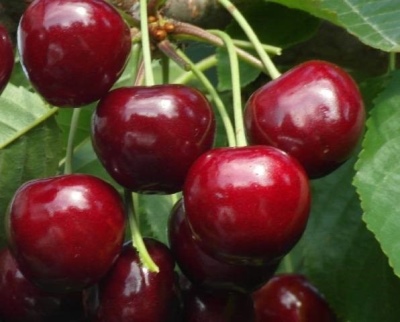
- Fruit shape: heart-shaped
- Authors: Syubarova E.P., Zhuk V.S., Vyshinskaya M.I., Sulimova R.M (Belarusian selection)
- Appeared when crossing: Northern x cherry pollen mixture
- Year of approval: 2002
- Growth type: medium-sized
- Appointment: for fresh consumption
- Yield: high
- Tree height, m: from 2.5 to 3.5
- Crown: wide pyramidal, raised
- Escapes: medium length and thickness, straight, brown
Sweet cherry Gronkovaya remains one of the most popular varieties of summer cottages. This is explained primarily by its taste and useful properties, as well as the ease of cultivation. The article describes the main characteristics of the crop, as well as tips for growing and caring for it.
Description of the variety
Although the cherry itself grows quite tall, this particular variety is not very tall. The tree stands out for its rapid growth, reaching from 2.5 to 3.5 meters in height. The crown is not too thick, it has the shape of a wide pyramid. Shoots are small and straight. The bark is brown. The leaves are very small in comparison with other varieties of cherries, they have an ellipsoidal shape. The color of healthy leaves is dark green.
Fruit characteristics
In shape, the dark red fruits of this tree resemble a small heart. The pulp is thick and juicy. The bones do not differ in their large size, and therefore it is convenient and easy to separate them before putting them into food. The weight of an individual fruit does not exceed 5.2 grams. In their natural form, berries are stored for a very short time, and therefore, for subsequent use, they must either be stored in the freezer or preserved.
Taste qualities
The berries are juicy and sweet in taste. According to the assessment of the tasting committee, taste gets 4.8 points out of 5. On average, the fruits are well suited for transportation and subsequent processing. Apart from being consumed in its natural form, cherries are also suitable for cooking compote and jams.
Ripening and fruiting
The harvest reaches full maturity around the end of the month of June. The berries are collected together with the stalks so that the fruits are not damaged. It is also worth noting that the fruits ripen unevenly, that is, not at the same time, and therefore the harvesting procedure can be repeated several times throughout the season.

Yield
Sweet cherry Gronkovaya is distinguished by high yield rates, and the collection of fruits itself takes place every year. So, from one hectare you can collect up to 90 centners of juicy and ripe berries. The size of the yield itself depends on the conditions in which the plant is located, as well as on how well all agrotechnical requirements are observed.
Growing and care
Like any other summer cottage plants, Gronkovaya cherry needs proper and accurate care throughout the year. It requires most attention in spring, summer, as well as before the winter months, when preparations are underway for the coming cold weather.
Loosening the soil is best done after rains. It is at this time that the earth and the roots of the tree absorb moisture and minerals best of all. In addition, the plant must be watered in a timely manner, and this applies to both seedlings and adult trees. By itself, watering should take place three times throughout the season.
Top dressing of cherries takes place in the autumn months. Moreover, before the process itself, it is necessary to dissolve mineral compounds in water, and then introduce this substance into the soil 20 centimeters deep. Such funds are bought in shops for summer cottages. In the spring, it is imperative to spray trees with special solutions to provide them with reliable protection from diseases and pests. The best time for this is when the air has become warm, but the leaves have not yet begun to bloom. The best way to treat a plant is considered to be a urea solution or "Nitrafen". Once the treatment has been completed, it is necessary to cover up the cracks and tear off the bark, which has already become too dry.
As for pruning, it is best done in the spring, before buds appear on the tree. You need to prune cherries every year, since the shoots of this plant are distinguished by rapid growth. This is best seen in the example of seedlings, whose growth remains intense for 5 years after planting. First, you need to cut off the branches that are closest to the trunk, as well as those that grow farther than the rest. Otherwise, the crown will be sloppy and overgrown.
As soon as the pruning has come to an end, the branches need to be treated with special glue to prevent gum leakage. Not only its beauty depends on whether the tree was cut correctly, but also health, and, consequently, yield. If the crown is too thick, the cherry will produce much less fruit. Special attention should be paid to preparing cherries for winter. To do this, first, the tree must be well watered, and then fertilized with humus and peat. Finally, as soon as the winter months are close, the cherries need to be treated with disinfectants, and then a frame with attached agrofibre should be placed around the trees. This device should provide the plant with good protection from the cold. It will not hurt to hide the trunk behind a metal mesh, so that it is not threatened by rodents.




Disease and pest resistance
Sweet cherry Gronkovaya is distinguished by strong immunity and good protection against a number of pests and diseases that other garden plants are usually exposed to. For example, this variety is highly resistant to coccomycosis, from which cherries usually suffer. However, one must not forget that all this is achieved with proper care, and the better the plant feels, the stronger the immunity will be. And also the tree needs to be regularly treated with agents to protect against pests and diseases.

































































